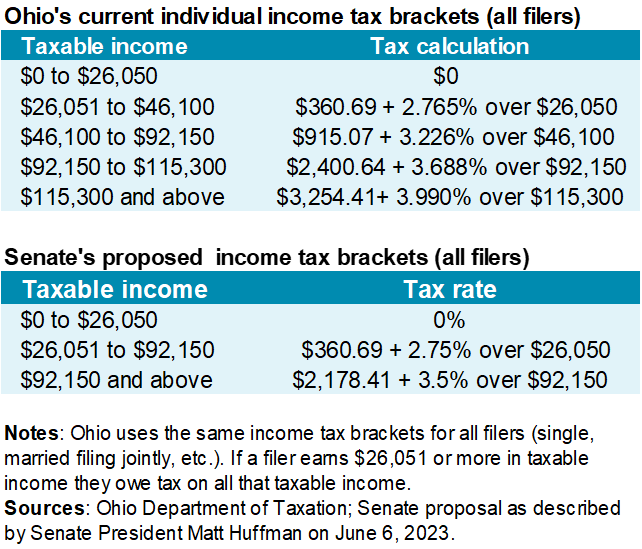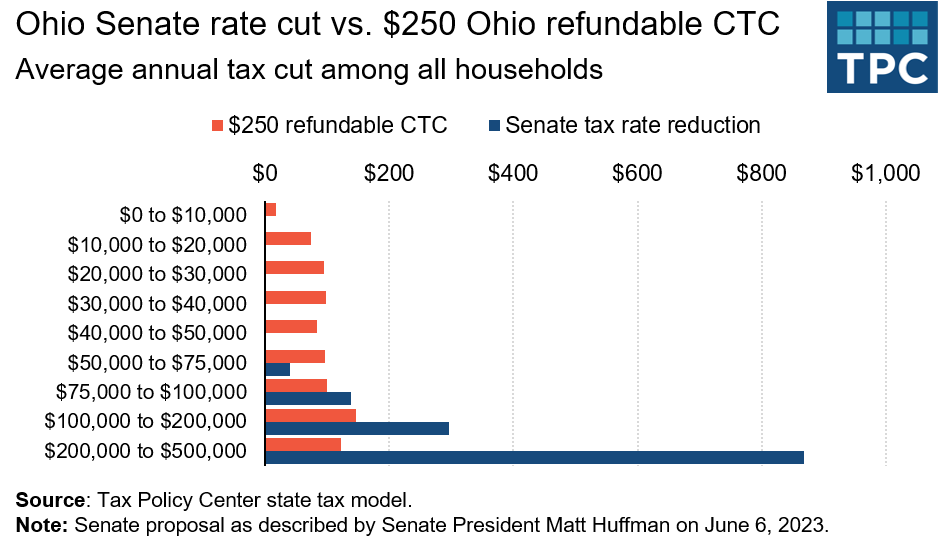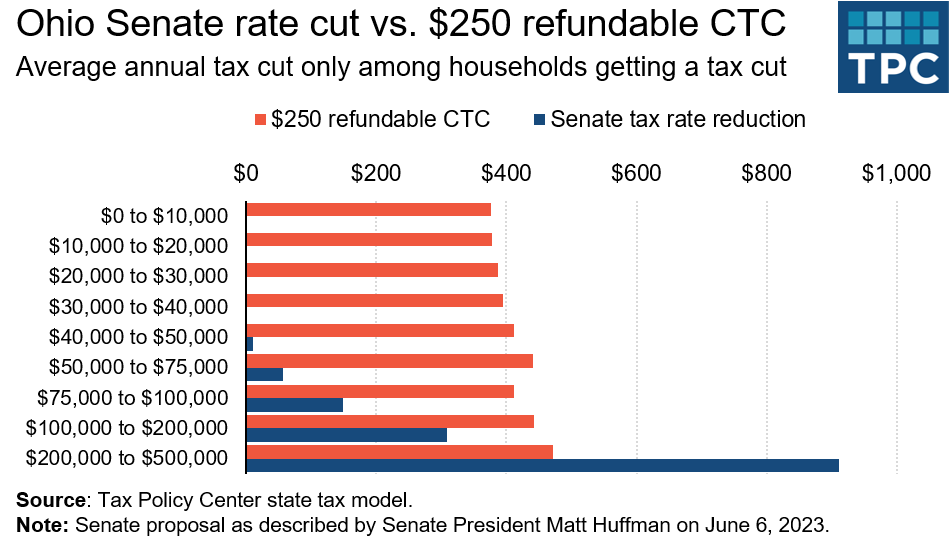Ohio Can Help More Families With Different Income Tax Cuts
Ohio’s House and Senate are debating the details of a tax cut, but both houses support plans to cut individual income tax rates and reduce state revenue by hundreds of millions of dollars annually. These plans come on the heels of a similar massive tax cut in 2021 that also reduced income tax rates.
While some argue income tax rate cuts help everyone – “This reform rewards the workforce,” said Sen. Matt Dolan – in practice, they cut a lot of Ohio families out of tax relief.
As Ohio’s legislature works on their final tax package, they should consider enacting a tax cut that helps groups other than Ohio’s highest earning households. To get that conversation started, we modeled a possible child tax credit (CTC) for Ohio families.
Rate cuts vs. tax credits
Tax rate cuts typically give the biggest benefits to those with the most taxable income. Why? Households with a lot of taxable income pay a lot in tax: those earning more than $100,000 in adjusted gross income (AGI) pay 71 percent of Ohio’s individual income taxes. So, if the only goal is reducing income tax payments, then rate cuts will work as intended.
But there are other reasons to cut taxes, such as helping working families. For this group, refundable credits are an effective tool to target relief, including offsetting the burden of other taxes (Ohio state and local governments collect 19 percent of their revenues from general and selective sales taxes compared with 12 percent from individual income taxes).
Ohio Senate proposal vs. an Ohio CTC
Ohio currently has five income tax brackets that all filers use (i.e., single and married filers), including a 0 percent bracket on the first $26,050 of taxable income. The 0 percent bracket is not the same as a standard deduction. If a household’s taxable income is below that threshold it pays no tax, but if it exceeds $26,050 by one dollar then the household owes tax ($360.69) on all that income. (Taxable income is calculated after deductions and exemptions, so these households earn more in AGI.)
The House proposal would eliminate one bracket and reduce tax rates while the Senate proposal would eliminate two brackets and cut rates.
With the Tax Policy Center’s state tax model, we analyzed the Senate’s proposal using 2022 Ohio tax law and income data. The Senate proposal delivers 85 percent of its benefits to households earning more than $100,000 in AGI; very little would go to households earning less than $50,000 in AGI.
Our hypothetical Ohio CTC was a $250 refundable credit based on the federal CTC: available to families with children younger than age 17 and phasing out at $200,000 of AGI ($400,000 for married couples). However, unlike the federal CTC, this credit has no phase-in, is fully refundable, and thus available to all low-income households.
The refundable Ohio CTC would provide benefits more evenly across income groups. The proposed income tax rate cut, on the other hand, provides substantially larger benefits to higher-income households.
Households earning more than $500,000 (average annual tax cut: $2,180) and more than $1 million (average annual tax cut: $8,860) are not shown on the graph because their average annual tax cuts would dwarf the others. In contrast, households in these income groups would get nothing from the CTC because of the phase-out.
But looking at all Ohio households undersells the CTC’s benefit to eligible families. In Ohio, 20 percent of households could claim the CTC, with roughly similar shares benefiting in each eligible income group. Meanwhile, 35 percent of households could benefit from the tax rate cut, but with very few households earning less than $50,000 benefiting and nearly all households earning more than $100,000 getting a tax cut.
Looking only at households receiving the tax cuts, the $250 refundable CTC delivers bigger cuts than the Senate proposal to eligible families in every income group except those earning more than $200,000.
The Tax Policy Center state tax model estimates the Senate proposal would cost $780 million annually, compared to $550 million annually for the $250 refundable CTC. Policymakers could thus deliver relatively large tax cuts to Ohio families with children across income groups and still have more than $200 million left for (more modest) rate cuts.
The income tax is a toolbox
The refundable CTC analyzed here is just one option. There are numerous ways to target benefits with the income tax, for example:
- For $315 million annually, Ohio could enact a nonrefundable $250 CTC. This would not help the state’s lowest-income households, but it would still provide significant tax relief to many middle-income families who would otherwise see little benefit from the rate cut.
- For $415 million annually, Ohio could enact a $500 refundable CTC but limit it to children younger than age 6 (Vermont does something similar).
- For $640 million annually, Ohio could make its earned income tax credit (EITC) refundable. Ohio is one of only four states with a nonrefundable EITC, and making the credit refundable would extend benefits to households earning less than $40,000. To limit revenue costs, the state could offer a refundable match lower than its current nonrefundable match (30 percent of the federal credit).
Alternatively, policymakers could create different brackets for single and married households, eliminating the state’s marriage penalty, or replace the 0 percent bracket with a standard deduction, eliminating the cliff that creates a tax liability for households earning one dollar above the bottom tax bracket.
If policymakers are set on simply reducing income tax payments, then a rate cut does that job. But there are many issues that policymakers can address with their state income tax if they’re willing to look beyond rate cuts.








